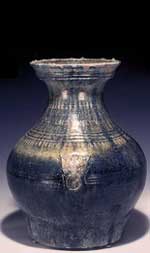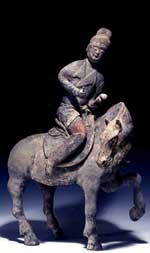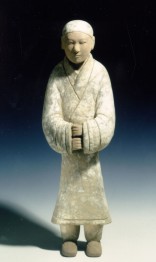 |

|
| |
| |
Collectors
of Chinese antiquities should be vary of tricksters, writes
D. T. Critchlow, author of a forthcoming book on the horses
of ancient China. Finding a reputable dealer for Tang dynasty
figurines or Han cases is essential, but it also helps if
you have enough rudimentary knowledge to sort out the cracks
from the pots.
Chinese
antique furniture and ceramics are all the rage in the West,
so given the availability, high quality and recession-induced
low prices of such antiques in Hong Kong there is now a rush
at galleries in Hollywood Road.
The
demand for Ming Furniture, Han vases, Tang "Fat Lady" figures
and wood carvings in cities such as New York, Los Angeles,
San Francisco, Houston, London and Paris seems insatiable.
"It's hard not to go into the home or office of an American
executive or corporate manager these days without finding
at least one Chinese antique," declares a dealer from Chicago.
"In fact, entire homes these days are being decorated in Chinese
themes." A young American executive who passed through Hong
Kong recently bought a 1,000-year-old Han vase to put on the
Mexican coffee table of his Los Angles home. Hollywood
Road has been Hong Kong's mecca for Chinese antiques since
the 1960s. Today, hundreds of shops can be found along this
narrow road that stretchers west above Central for more than
a mile. Galleries offer a range of goods, both authentic and
detailed modern reproductions, and it is certainly the place
to go if you are seeking high-quality museum pieces- a Neolithic
painted pot, a Tang horse or a Ming marriage processional
figure, for example. Pieces of the highest quality, with guaranteed
authenticity, can be found at bargain prices, especially when
compared to London, Paris or New York. It is no wonder that
Hollywood Road was recently voted " one of the 10 best shopping
streets in the world".
But
the smart buyer must be wary of tricksters. When dealing with
a novice or an unsuspecting tourist, some outlets in Hollywood
Road may represent a modern reproduction as a genuine antique.
It pays for a first-time buyer, as much as it does for an
experienced collector, to be able to tell a fake from an authentic
piece. Victor Choi, owner of Dragon Culture, who has two galleries
in Hollywood Road, offers this advice: "The key to collecting
is to find a reputable dealer, who will spend time with you
to find out your interests and to tell you about each piece."
Choi
encourages buyers to have their more expensive purchases scientifically
tested. For wood, a carbon 14 test is available. For pottery,
Oxford University provides an authenticity certificate based
on a thermoluminescence test. London company Oxford Authentication
Ltd will date the origin of an artifact to within a few hundred
years. |
|  |
| |
While
the Oxford University test, which costs about $3,000, certifies
authenticity, at a glance a professional dealer can assess
a piece according to its patina, style, weight, colour, hardness
of clay and general look. This ability to "eye" an artifact
comes from the experience of examining hundreds of thousands
of pieces. Thus the reputation of the dealer is important
when acquiring Chinese art and often allows the buyer to avoid
the additional expense of an Oxford test. Once he has located
a reputable dealer, the buyer needs to determine the kind
of antiques he likes and will fit into his home or office.
Each dynasty has a unique style of production. Knowledge of
the historical development of firing and glazing techniques
gives even the novice the means to identify Chinese ceramics.
For example, the earliest Chinese pottery is the unglazed
earthenware of the Neolithic culture of northern China, produced
in the early part of the second millennium BC. Neolithic pottery
displays striking beauty in its primitive geometric painted
designs, which are remarkably similar to works produced much
later by the Navajo tribe in the southwest of the North American
continent.
The
Shang dynasty (1750-1045 BC) saw the introduction of glazing,
but the period is best known for the beautiful bronze vessels
illustrate the power and vitality of this epoch in Chinese
history. They range in height from a few inches to more than
four feet and are valued for their short inscriptions.
Poetry
and music flourished during the Chou dynasty (1045-22 BC) - the
age of Confucius - and bronzes were made with elaborate inscriptions.
Intricate, interlacing patterns were used to represent animal forms.
Bronze "spade" money appeared in the Warring States period (480-22
BC) and the rich adorned their furniture and carriages with bronze
fittings inlaid with fold, silver and malachite. The fashion had
an effect on ceramics as artisans tried to replicate bronze shapes
and patinas. Han vases are exquisite in their magnificent reddish
brown and deep green glazes. During the Han dynasty (202 BC - 220
AD) pottery figures of dancers and court musicians and amber-glazed
hill jars were produced. The fascination with horses in Han culture
resulted in a varied of pottery horse figures, both glazed and unglazed,
with detailed painting to reveal saddles, saddlecloths, reins, and
trappings.
In
439, north China came under the rule of the Toba Wei. During
this period, Buddhism profoundly influenced Chinese culture
and art, and Buddhist stone sculpture and painting flourished.
Some of the best ceramic grave figurines have an almost fairy-like
elegance, while the horses are no longer the tough, stocky,
deep-chested creatures of Han art; they exhibit a heraldic
grace of form.
The
Northern and southern dynasties (429-589) and the Sui dynasty
(581-618) set the stage for the glorious period in Chinese
arts that would be the Tang dynasty. While the Sui dynasty
was short lived, the ceramics produced in these years are
prized among collectors. It is worth comparing Sui horses,
with their heavy bodies and long tails, to the highly stylised
form of Tang horses. |
|  |
| |
Chinese
culture proposed in the Tang dynasty (618-907). The famous
Tang horses and their riders come in a wide variety of shapes
and poses. Tang artists ably captured the movement of the
beasts, portraying gaping mouths, extended tails, raised legs
and bent heads. Riders run the gamut from court officials
and traders to foreigners with beards. Representation of the
extensive trade along the Silk Road is found in beautifully
crafted camel figurines. Tang craftsmen also perfected horses
and camels in Sancai glaze (three colours).
The
Song dynasty (900-1279) is noted for its Buddhist and Bodhisattva
stone carvings that impart a new splendour of effect. Tens
of thousands of celadon pieces were exported throughout Asia
in the Southern Song era, turning up as far away as Egypt,
where they were much in demand by Arab potentates. Especially
beautiful is Ying Ching ware, known for it fine, granular,
sugary body and pale bluish cast.
Collectors
of Chinese antiquities have a seemingly endless choice of
style and form. Whatever you decide to acquire, it will surely
be a conversation piece in the home or office. To aid your
deliberations, many excellent books on Chinese art were available.
Victor Choi has himself produced a short handbook that serves
as a useful guide to the buyer, Collecting Chinese Antiques
in Hong Kong.
Visiting
one of Choi's two galleries in Hollywood Road is to enter
a wonderland of Chinese arts and crafts. The collections have
an astonishing richness. Pride of place in the Dragon Culture
gallery at 184 Hollywood Road is a massive 112-centimetre-high
Han pottery amber-glazed horse. There are also Han green-glazed
vases, Yuen vases, Northern Wei figurines and Tang "Fat Ladies".
There is an area reserved for stone carvings including some
fine stone Buddha heads. Antique furniture is displayed on
the second floor, along with Tang horses and Ming figurines.
At
the Dragon Culture gallery at 231 Hollywood Road, the browser
encounters Choi's extensive bronze collection, including rings,
wine vessels and bells, and a collection of jade. As Choi's
main interest is wholesale, his shops are more reminiscent
of warehouses than they are of art boutiques. This means,
of course, that individual collectors can often get wholesale
prices. |
|  |
| |

|
|